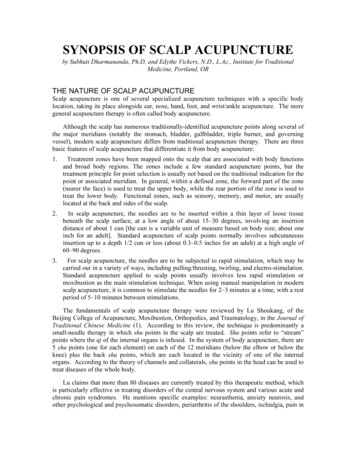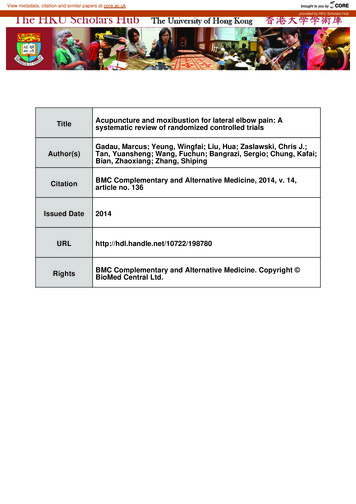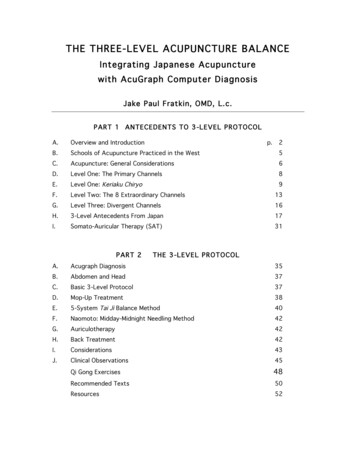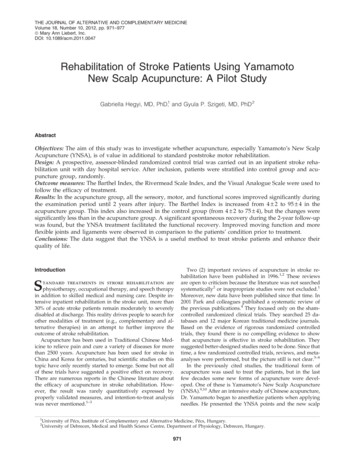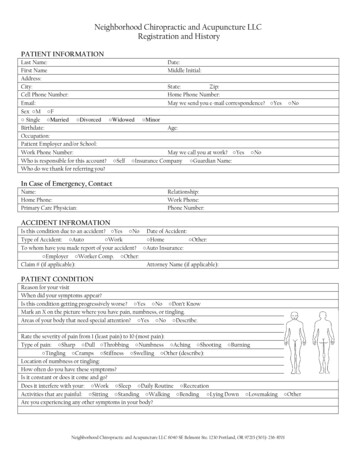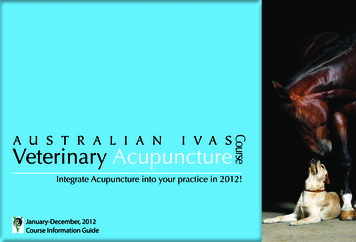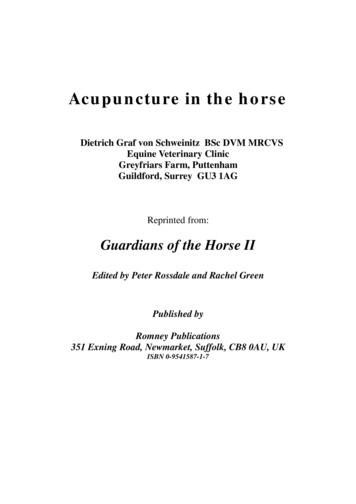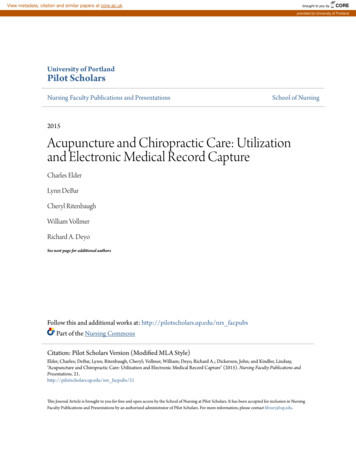
Transcription
View metadata, citation and similar papers at core.ac.ukbrought to you byCOREprovided by University of PortlandUniversity of PortlandPilot ScholarsNursing Faculty Publications and PresentationsSchool of Nursing2015Acupuncture and Chiropractic Care: Utilizationand Electronic Medical Record CaptureCharles ElderLynn DeBarCheryl RitenbaughWilliam VollmerRichard A. DeyoSee next page for additional authorsFollow this and additional works at: http://pilotscholars.up.edu/nrs facpubsPart of the Nursing CommonsCitation: Pilot Scholars Version (Modified MLA Style)Elder, Charles; DeBar, Lynn; Ritenbaugh, Cheryl; Vollmer, William; Deyo, Richard A.; Dickerson, John; and Kindler, Lindsay,"Acupuncture and Chiropractic Care: Utilization and Electronic Medical Record Capture" (2015). Nursing Faculty Publications andPresentations. 21.http://pilotscholars.up.edu/nrs facpubs/21This Journal Article is brought to you for free and open access by the School of Nursing at Pilot Scholars. It has been accepted for inclusion in NursingFaculty Publications and Presentations by an authorized administrator of Pilot Scholars. For more information, please contact library@up.edu.
AuthorsCharles Elder, Lynn DeBar, Cheryl Ritenbaugh, William Vollmer, Richard A. Deyo, John Dickerson, andLindsay KindlerThis journal article is available at Pilot Scholars: http://pilotscholars.up.edu/nrs facpubs/21
MANAGERIALAcupuncture and Chiropractic Care: Utilizationand Electronic Medical Record CaptureCharles Elder, MD, MPH; Lynn DeBar, PhD, MPH; Cheryl Ritenbaugh, PhD, MPH; William Vollmer, PhD;Richard A. Deyo, MD, MPH; John Dickerson, PhD; and Lindsay Kindler, PhD, RNAcupuncture and chiropractic care are popularamong patients, especially those who suffer fromchronic musculoskeletal pain.1 Caring for thispopulation has become an increasingly important and visible challenge for the healthcare system. Pharmaceuticals arecommonly used for managing pain, yet the use of such agentson a chronic basis is of questionable efficacy, and can be associated with high costs and significant adverse effects.2,3 Forexample, nonsteroidal anti-inflammatory drugs can cause ManagedCarewhile& use of narcoticgastrointestinal toxicityor renal failure,HealthcareCommunications,LLCanalgesics can be associated with somnolence, constipation,addiction, diversion of medications, and other problems.Although many health insurers cover acupuncture andchiropractic care for pain management, such coverage is often limited in scope, and integration of acupuncture and chiropractic care with conventional practice may be piecemealor nonexistent.4-10 Health insurance providers may allow patients to self-refer for acupuncture and chiropractic care, ormay require patients to first obtain a referral from a primarycare physician. Which mechanism is optimal in terms of patient satisfaction, inter-clinician communication, and clinical outcomes has not been explored.Ultimately, better integration may require a more robustevidence base toward identifying the optimal clinical contextfor acupuncture and chiropractic use. In developing such anevidence base, attention is turning to analyses of data fromclinical and administrative electronic medical records (EMRs)to enhance both conventional and innovative study designs.11EMRs contain potentially useful information on large numbers of patients that is already being collected in the contextof routine care delivery. It is unclear, however, to what extentsuch electronic databases contain information about acupuncture and chiropractic utilization that is accurate or complete.We recently surveyed chronic musculoskeletal pain patients in a large health maintenance organization (HMO) toascertain the extent to which EMRs are capturing acupunc-e414nA B STR AC TObjectives: To describe acupuncture and chiropractic use amongpatients with chronic musculoskeletal pain (CMP) at a healthmaintenance organization, and explore issues of benefit designand electronic medical record (EMR) capture.Study Design: Cross-sectional survey.Methods: Kaiser Permanente members meeting EMR diagnosticcriteria for CMP were invited to participate. The survey includedquestions about self-identified presence of CMP, use of acupuncture and chiropractic care, use of ancillary self-care modalities,and communication with conventional medicine practitioners.Analysis of survey data was supplemented with a retrospectivereview of EMR utilization data.Results: Of 6068 survey respondents, 32% reported acupunctureuse, 47% reported chiropractic use, 21% used both, and 42% usedneither. For 25% of patients using acupuncture and 43% of thoseusing chiropractic care, utilization was undetected by the EMR.Thirty-five percent of acupuncture users and 42% of chiropracticusers did not discuss this care with their health maintenanceorganization (HMO) clinicians. Among chiropractic users, thoseaccessing care out of plan were older (P .01), were more likely touse long-term opioids (P .03), and had more pain diagnoses (P .01) than those accessing care via clinician referral or self-referral.For acupuncture, those using the clinician referral mechanismexhibited these same characteristics.Conclusions: A majority of participants had used acupuncture,chiropractic care, or both. While benefit structure may materiallyinfluence utilization patterns, many patients with CMP use acupuncture and chiropractic care without regard to their insurancecoverage. A substantial percentage of acupuncture and chiropractic use thus occurs beyond detection of EMR systems, and manypatients do not report such care to their HMO clinicians.Am J Manag Care. 2015;21(7):e414-e421www.ajmc.comnJULY 2015
Acupuncture and Chiropractic Careture and chiropractic utilization amongTake-Away Pointstheir membership. In particular, we addressn A majority of health maintenance organization (HMO) participants with chronicthe following questions:musculoskeletal pain had used acupuncture, chiropractic care, or both.1. Description of acupuncture and chin While benefit structure may materially influence utilization patterns, many patients with chronic pain use acupuncture and chiropractic care without regard to theirropractic use. What is the prevalence ofinsurance coverage.self-reported acupuncture and chiropracn A substantial percentage of acupuncture and chiropractic use occurs beyond detic use among chronic musculoskeletaltection of electronic medical record systems, and many patients do not report theiracupuncture and chiropractic utilization to their HMO clinicians.patients at the HMO? Which types ofn Better acupuncture and chiropractic integration offers opportunities for improvedpatients use acupuncture? Chiropracticmanagement algorithms and more efficient utilization of resources.care? What are the perceived barriers tosuch use? How often do acupuncture andcapitated basis. We describe this mechanism for accessingchiropractic users communicate such usecare as “self-referral.”to their HMO clinicians?KPNW infrastructure includes a comprehensive EMR2. Medical record capture. To what extent is acupunctureand chiropractic utilization captured by the HMO’s EMR? used for all patient encounters. This EMR allows for3. Utilization and benefit coverage. How, if at all, do tracking of patient demographics, diagnoses, referrals,patients who access acupuncture and chiropractic care billing, and utilization. We are thus able to capture acupuncture and chiropractic services billed and receivedthrough various mechanisms differ from one another?through the “clinician referral” mechanism electronicallywith the KPNW EMR. For this analysis we accessed EMRMETHODSdata for the years 2009 to 2011.CHP also maintains an electronic database, trackingSetting and Coverage PoliciesKaiser Permanente Northwest (KPNW) is a group mod- visits, diagnoses, and procedures for “self-referral” pael HMO serving approximately 500,000 members in Or- tients. Electronic data from the CHP database were availegon and Washington. KPNW members can be referred able for this analysis for the year 2011.by an HMO clinician for acupuncture and chiropracticcare based upon locally developed evidence-based referral ParticipantsWe developed a comprehensive International Classificaguidelines.12,13 In brief, for chiropractic care, referrals areapproved for acute nonradicular back or neck pain. Acu- tion of Diseases, Ninth Revision, Clinical Modification codepuncture referrals can be approved for most chronic pain list to identify patients whose pattern of clinical diagnosesconditions. Acupuncture and chiropractic care are pro- in their EMR was consistent with chronic musculoskeletalvided by clinicians affiliated with Complementary Health pain.14 The sample was operationally defined as includingPlans (CHP), a network of credentialed acupuncturists KPNW members aged at least 18 years at the time of theirand chiropractors with which KPNW contracts. CHP first medical visit with a pain-related diagnosis, with 3acupuncturists and chiropractors bill KPNW directly for outpatient (ie, emergency department, ambulatory visit,services provided under this mechanism. We describe this e-mail, or telephone) encounters evident in the EMR,mechanism for accessing care as “clinician referral.”spanning at least 180 days but no more than 18 months.In addition, many KPNW members or their employ- We required appropriate diagnostic codes indicating: 3 ocers have purchased a self-referral insurance rider, which currences of musculoskeletal pain diagnoses; or first diagallows patients to directly access a CHP acupuncturist or nosis of musculoskeletal pain and 2 subsequent diagnoseschiropractor for any indication, up to annual utilization of nonspecific chronic pain; or first diagnosis of musculimits. Payment for these benefits is made on a capitated loskeletal pain with 1 additional musculoskeletal pain dibasis from KPNW to CHP, and acupuncture and chiro- agnosis and 1 nonspecific chronic pain diagnosis. Thesepractic clinicians thus bill CHP for office visits and servic- eligibility criteria are described in more detail elsewhere.14es provided. Approximately one-third of KPNW patientsreside in southwest Washington, where some coverage of Survey Methodsacupuncture and chiropractic services is mandated by thePatients meeting the criteria for chronic musculostate, while the remainder live in Oregon, where there is skeletal pain described above between 2009 and 2011no such mandate. All KPNW Washington members have were invited to complete a survey online, by mail, or bya self-referral benefit for chiropractic care, paid for on a phone. The invitation emphasized a broad interest inVOL. 21, NO. 7nTHE AMERICAN JOURNAL OF MANAGED CAREne415
MANAGERIALidentifying treatment and self-care activities to managepersistent pain, framed as “We want to know what worksfor you.” The survey included questions related to selfidentified presence of chronic pain, self-reported use ofacupuncture and chiropractic care, use of ancillary selfcare modalities (ie, yoga, tai chi/qigong, supplements,massage, meditation, physical activity, diet, other), andcommunication with conventional medicine practitioners about acupuncture and chiropractic use. Where patients indicated through survey response that they hadutilized acupuncture or chiropractic care without usingtheir HMO insurance, we designated such access to careas “out of plan.”Prior to survey implementation, we pretested the survey with 5 patients with chronic musculoskeletal painidentified from participants in a psycho-educational program for pain patients offered through the KPNW painclinic. From this group, we selected for interview patientswho, upon completing the draft survey, either had selfidentified using out-of-plan complementary/alternativemedicine (CAM) services or those whose response patterns evidenced confusion regarding survey questions.The goal of the interviews was to obtain patient feedbackregarding important points missed and to tailor wordingto enhance acceptability and avoid ambiguity.Members meeting chronic musculoskeletal pain criteriawere contacted by mail with a postcard inviting them to logon to a website to complete the survey online. The initialonline response rate to the post card was 4% (N 1731).After 2 weeks, those who did not respond were contactedby e-mail (N 4885) or were sent a paper copy of the surveyby US mail (N 34,211). Finally, 10% of nonresponders—selected based upon the date they had been mailed thesurvey—were called and invited to complete the surveyby phone. Ultimately, of the surveys completed, approximately 5% were completed by phone, 18% were completedonline, and 77% were completed on paper and mailed back.AnalysisChi-square tests were used for comparisons on categorical variables. ANOVA was used for continuous variables. As our purpose was to generate, rather than test,hypotheses, we did not correct for multiple comparisons.RESULTSDescription of Acupuncture and Chiropractic UseOf 49,426 patients invited to participate, 8264 (16.7%)participants responded. Of these, 6068 (73.4%) self-reported chronic musculoskeletal pain and as such, the focus ofe416nthis manuscript. These 6068 participants were predominantly Caucasian (94%) and female (71%), with a meanage of 61 years (SD 13). Thirty-two percent reported acupuncture use for pain, while 47% reported chiropractic usefor pain. The number reporting both acupuncture andchiropractic use was 21%. Forty-two percent of respondents used neither acupuncture nor chiropractic care.The 4 usage groups differed significantly in age andgender (Table 1). In addition, the percentage of participants self-reporting back pain, neck pain, muscle pain,headache, fibromyalgia, or abdominal/pelvic pain washighest in the group using both acupuncture and chiropractic services.Barriers. Among the 4113 individuals who reportednever having used acupuncture services, the most commonly cited reasons were: never considered doing so, cost,and didn’t know a reputable provider (Table 2). Amongthe 3211 individuals who reported never having used chiropractic services, the most commonly cited reasons were:never considered, didn’t think it would help, and cost.Communication. Of those using only acupuncture, 35%did not discuss their acupuncture use with their primarycare provider, while 42% of those using only chiropracticservices did not discuss their chiropractic use (Table 3).However, most of these individuals indicated that theywould do so if asked about such use.Medical Record CaptureFigures 1 and 2 describe the distribution of utilizationfor acupuncture and chiropractic care across different referral mechanisms for the year 2011.For acupuncture, data were captured for 667 patients.Of these, 168 (25%) utilized acupuncture entirely out ofplan, and were not captured by the EMR. Overall, 229(34%) users of acupuncture were treated with some acupuncture out of plan. More than half (55%) of patientsusing acupuncture in 2011 did so entirely based uponclinician referral, while 9% of patients used acupunctureentirely based upon a self-referral benefit. Of 428 patientswho used a clinician referral, 52 (12%) supplemented theirhealth plan benefit with additional out-of-plan utilization.For chiropractic care, data were captured for 887 patients. Of these, 381 (43%) utilized chiropractic servicesentirely out of plan, and thus were not captured by theEMR. Overall, 478 (54%) participants used at least sometype of chiropractic care out of plan; 323 patients (36%)utilized a chiropractor based solely upon self-referral benefit coverage; and only 78 patients (9%) did so based solelyupon clinician referral. Of the 408 patients who used chiropractic care in 2011 using a self-referral benefit, 77 (19%)www.ajmc.comnJULY 2015
Acupuncture and Chiropractic Caren Table 1. Participant Demographics and Reported Pain DiagnosesFemale (%)Age (mean SD)Caucasian (%)TotalSampleN 8264Respondentsn 6068Used ChiroOnlyn 1579Used AcuOnlyn 677UsedBothn 1278No Acu/Chiro Usen 2534PaN 6068697168757668 .000161 1461 1359 1361 1458 1364 13 .0001939495949494.6374Self-reported diagnoses from survey (%)Back pain–6475627651 .0001Joint mity pain–5655575656.67390018Neck pain–3847365326 .0001Muscle pain–3132314125 .0001Headache–2326223315 .0001Fibromyalgia–1516172211 .0001Abdomen/pelvis–10129139 .0001Other–10913119.0190Acu indicates acupuncture; chiro, chiropractic care.aTwo-tailed P for comparing 4 usage groups based on 1-way ANOVA (continuous data) or Pearson χ2 test (proportions).supplemented their self-referral health plan benefit withadditional out-of-plan utilization.Thus, for acupuncture, most utilization was basedupon clinician referral. In contrast, for chiropractic care,relatively little utilization was based upon clinician referral, with the great majority of patients accessing care outof plan only, through self-referral, or both.Utilization and Benefit CoverageFor this set of analyses, data are included for the subsetof patients indicating 2011 utilization. “Out of plan only”describes participants in area C of the Venn diagramsof Figures 1 and 2. “Clinician referral” describes participants in areas A F of the Venn diagrams: those whoused the clinician referral mechanism for at least some oftheir care. “Self-referral” describes participants in areas B G of the Venn diagrams: those who used the self-referralmechanism for at least some of their care. The small number of patients in areas D and E were dropped.There were no differences among the 3 groups (ie,out-of-plan only, clinician referral, and self-referral) withrespect to gender, ethnicity, or smoking status. For chiropractic, there was a tendency for those accessing care outof plan only to be older (mean age 58 years; SD 13; P .01), to use long-term opioids (16%; P .03), and to havemore pain diagnoses (mean 4.2; SD 2.1; P .01). Foracupuncture, there was a tendency for those using a clinician referral mechanism to exhibit these same characteris-VOL. 21, NO. 7ntics (mean age 59 years, SD 13, P .01; long-term opioiduse 21%, P .02; mean number of pain diagnoses 4.0,SD 2.1, P .01). Acupuncture patients receiving clinicianreferral care were also less educated compared with thoseusing self-referral or out-of-plan only care (high school/GED or less 20%, some college 44%, college graduate ormore 36%; P .01).For chiropractic users, the most commonly used additional CAM modality was massage (55% for out-of-planonly, 57% for clinician referral, and 53% for self-referral).However, there were no significant differences among the3 utilization groups with respect to self-reported use of anyof the additional CAM modalities, including massage,yoga, tai chi/qigong, supplements, meditation, physicalactivity, diet, or other. For acupuncture users, the mostcommonly used additional CAM modality was also massage (52% for out-of-plan only, 46% for clinician referral,and 56% for self-referral). Acupuncture users accessingcare through self-referral were more likely than clinicianreferral or out-of-plan only users to report use of dietary(23%; P .02) or other (24%; P .03) modalities.Participants accessing acupuncture via clinician referral were significantly more likely than those accessing acupuncture via self-referral or out of plan only to self-reportpain in the back (73%; P .01), muscles (41%; P .03), orpain due to arthritis (54%; P .01). For chiropractic care,those obtaining care out-of-plan only were significantlymore likely to report extremity pain (59%; P .02).THE AMERICAN JOURNAL OF MANAGED CAREne417
MANAGERIALn Table 2. Reasons for Not Seeking Acupuncture or Chiropractic ServicesNever Used Acupuncture(n 4113)Never Used Chiropractic(n 3211)Prev (%)95% CIPrev (%)95% CICost2826.3-29.01715.3-17.9Don’t know reputable provider1817.1-19.4108.6-10.6Discomfort with or fear of the procedure87.4-9.11513.9-16.4Safety concerns54.2-5.51412.7-15.1Don’t think it will help1311.7-13.82321.3-24.2Never considered4543.3-46.43129.1-32.3Prev indicates prevalence.n Table 3. Patterns of Reporting Acupuncture and Chiropractic to ProviderN 2200Used Only Acu(n 668)aUsed Only Chiro(n 1532)aPrev (%)Prev (%)No, I would never do this12No, but would tell if asked3440Shared some info2725Shared everything302677OtherAcu indicates acupuncture; chiro, chiropractic care; prev, prevalence.aExcludes those missing responses to the question (acu only, n 9; chiro only, n 47), 2-tailed P .048 based on Pearson χ2 .DISCUSSIONThe use of acupuncture and chiropractic care amongHMO chronic pain patients responding to our survey wassubstantial. Those using neither acupuncture nor chiropractic care (42%) were in the minority. The data alsosuggest that a substantial percentage of acupuncture andchiropractic use is not documented by the EMR, and/oris not reported by patients to their HMO clinicians.While investigators may use clinical and administrative databases to enhance study design, results suggestthat EMR data fail to detect a substantial percentage ofacupuncture and chiropractic utilization, even in an integrated delivery system with allowable referrals to acupuncture and chiropractic care, as well as a state-of-the-artEMR system. Any EMR-based analysis of acupunctureand chiropractic use would require additional survey orother data collection to capture the full spectrum of care.Clinicians should assume that a substantial percentage of their patients with chronic musculoskeletal painare receiving acupuncture and chiropractic care. For bothacupuncture and chiropractic users, the most commonlyendorsed answer to the question, “Did you share information about acupuncture/chiropractic use with youre418nHMO clinician?” was “No, but would tell if asked.” Thisfinding serves to emphasize the importance of cliniciansraising this topic in routine encounters with chronic painpatients. Engaging the patient in a discussion about acupuncture and chiropractic use can provide informationfor optimizing care. Such discussions can reinforce a patient’s self-management efforts and potentially provideinsight into the types of patients who may be, or shouldbe, using acupuncture and/or chiropractic services. Clinicians should also consider direct communication withacupuncturists and chiropractors about patients they areco-managing. This may allow better coordination of careand will potentially improve outcomes.Our data suggest that, to a substantial extent, insurancebenefits influence who uses acupuncture and chiropracticcare, and under what circumstances. For acupuncture,the majority of utilization was based upon clinician referral. In contrast, for chiropractic care, relatively little utilization was based upon clinician referral, with the greatmajority of patients accessing care out of plan (with noinsurance coverage), through self-referral, or both. Chiropractic care may be commonly used for chronic painby patients, but at KPNW, medical necessity criteria limitclinician referrals for chiropractic care to acute pain. Inwww.ajmc.comnJULY 2015
Acupuncture and Chiropractic Caren Figure 1. Acupuncture Use in 2011Clinician ReferralSelf–ReferralDn 11(1.7%)n 365(54.7%)An 49(7.4%)n 3(0.5%)En 62(9.3%)Bn 9(1.4%)FGn 168(25.2%)COut–of–PlanThose who responded to the survey met our definition for chronic musculoskeletal pain at the time of the survey, and self-reported chronic pain on thesurvey (N 667).n Figure 2. Chiropractic Use in 2011Clinician ReferralSelf–ReferralDn 8(0.9%)n 78(8.8%)An 323(36.4%)n 1(0.1%)n 20(2.3%)EBn 76(8.6%)GFn 381(43.0%)COut–of–PlanThose who responded to the survey met our definition for chronic musculoskeletal pain at the time of the survey, and self-reported chronic pain on thesurvey (N 887).VOL. 21, NO. 7nTHE AMERICAN JOURNAL OF MANAGED CAREne419
MANAGERIALaddition, Washington patients all have a self-referral insurance rider for chiropractic care, but not for acupuncture, making it easier for Washington members to accesschiropractic services by self-referral. At the same time,patients seeking chiropractic care may be dissuaded fromusing HMO benefits when the fee per visit for obtainingchiropractic care out of plan is only marginally higherthan their HMO co-pay.For chiropractic services, there is a tendency for “outof-plan only” users to be older, to use long-term opioids,and to have more pain diagnoses. For acupuncture, thereis a tendency for those using the clinician referral mechanism to exhibit these same characteristics. This is consistent with the acupuncture referral guidelines, which allowfor care only in the setting of chronic, as opposed to acute,pain. Chiropractic benefits for self-referral are limited inthe dollar amount allowed, and for clinician referral, areconstrained by referral guidelines allowing use only foracute pain. Those who desire ongoing maintenance treatments will go out of plan due to necessity.The substantial percentage of participants indicatingout-of-plan use suggests that many chronic pain patientsare determined to use acupuncture and chiropractic care,regardless of their insurance coverage. In this context, andin the face of the high prevalence of acupuncture and chiropractic use, policy makers may need to consider betterways of covering and integrating acupuncture and chiropractic care into conventional delivery systems.15,16 Manychronic pain patients may consider acupuncture andchiropractic coverage important when selecting a healthinsurance plan. In addition, better acupuncture and chiropractic integration could offer potential opportunitiesfor improved management algorithms and more efficientutilization of resources.17,18 The potential for these 2 typesof care to serve as noninvasive alternatives to pharmacologic and procedural interventions, or as tools to facilitatethe reduction of chronic pharmacotherapy, would seemto warrant further investigation.19,20Strengths and LimitationsThe study’s strengths include a large sample size, aswell as the availability of a comprehensive EMR system.Multiple pathways to acupuncture and chiropractic careexist within the HMO, which we were able to electronically track and compare. In addition, we were able to supplement EMR data with survey data to gain a more completepicture of overall acupuncture and chiropractic utilization. Limitations include a relatively low survey responserate. We did not attempt to contact nonresponders to determine possible reasons for this. Furthermore, survey re-e420nsponders may not accurately represent the broader groupof patients who suffer from chronic pain. Comparing survey responders who self-reported chronic pain with nonresponders, using EMR demographic and diagnostic data(6 comparisons), we found that responders were more likely to be female or Caucasian and were less likely to smoke,and more likely to have had an acupuncture referral (P forall .01). It is likewise unclear to what extent any findingsor conclusions may be applicable to other healthcare venues beyond an HMO setting, or beyond KPNW.CONCLUSIONSIn our analyses, a majority of HMO participants withchronic musculoskeletal pain have used acupuncture, chiropractic care, or both. While benefit structure may materially influence utilization patterns, many patients withchronic musculoskeletal pain use acupuncture and chiropractic care without regard to their insurance coverage.A substantial percentage of acupuncture and chiropracticuse thus occurs beyond detection of EMR systems, andmany patients do not report their acupuncture and chiropractic utilization to their HMO clinicians.Author Affiliations: Kaiser Permanente Center for Health Research(CE, LD, WV, JD, LK), Portland, OR; University of Arizona (CR), Tucson, AZ; Oregon Health and Science University (RAD), Portland, OR.Source of Funding: The project was supported by a grant (R01AT005896) from the National Center for Complementary and Integrative Health, National Institutes of Health (NIH).Author Disclosures: Dr Deyo has received federally funded grantsand has grants pending from the Patient-Centered Outcomes Research Institute and NIH. Drs Elder, Kindler, Vollmer, DeBar, Ritenbaugh, and Dickerson report no relationship or financial interest withany entity that would pose a conflict of interest with the subject matterof this article.Authorship Information: Concept and design (CE, LD, CR, WV, LK,RAD); acquisition of data (CE, LD, JD); analysis and interpretation ofdata (CE, LD, CR, WV, JD, RAD); drafting of the manuscript (CE, LD,CR, RAD); critical revision of the manuscript for important intellectualcontent (CE, LD, CR, WV, RAD); statistical analysis (CE, WV, JD); provision of patients or study materials (LK); obtaining funding (LD, CR, WV);administrative, technical, or logistic support (LK).Address correspondence to: Charles Elder, MD, Kaiser PermanenteNorthwest, Center for Health Research, 3800 N Interstate Ave, Portland,OR 97227. E-mail: Charles.Elder@kpchr.org.REFERENCES1. Barnes PM, Bloom B, Nahin RL. Complementary and alternativemedicine use among adults and children: United States, 2007. NatlHealth Stat Report. 2008;(12):1-23.2. Beebe FA, Barkin RL, Barkin S. A clinical and pharmacologic reviewof skeletal muscle relaxants for musculoskeletal conditions. Am J Ther.2005;12(2):151-171.3. Von Korff M, Kolodny A, Deyo RA, Chou R. Long-term opioid therapyreconsidered. Ann Intern Med. 2011;155(5):325-328.4. Bell IR, Caspi O, Schwartz GE, et al. Integrative medicine and systemic outcomes research: issues in the emergence of a new model forprimary health care. Arch Intern Med. 2002;162(2):133-140.www.ajmc.comnJULY 2015
Acupuncture and Chiropractic Care5. Nahin RL, Pontzer CH, Chesney MA. Racing toward the integrationof complementary and alternative medicine: a marathon or a sprint?Health Aff (Millwood). 2005;24(4):991-993.6. Kaptchuk TJ, Miller FG. Viewpoint: what is the best and mostethical model fo
use, 47% reported chiropractic use, 21% used both, and 42% used neither. For 25% of patients using acupuncture and 43% of those using chiropractic care, utilization was undetected by the EMR. Thirty-five percent of acupuncture users and 42% of chiropractic users did not discuss this care with their health maintenance organization (HMO) clinicians.

